The Impact of Loneliness on University Students' Well-being
VerifiedAdded on 2022/11/30
|17
|3251
|339
Report
AI Summary
This report investigates the pervasive issue of loneliness among university students, exploring its multifaceted dimensions and detrimental impacts on their well-being. The study delves into the root causes of loneliness, including personality traits, social isolation, and communication challenges, while also examining the effects on both mental and physical health. The research highlights the prevalence of anxiety, depression, and inadequate dietary behaviors, alongside the difficulties in sleep and concentration, experienced by lonely students. The report draws upon survey data and secondary research to provide a comprehensive overview of the issue. Furthermore, it discusses the coping strategies employed by students, such as engagement in sports, entertainment, and spending time with family. The conclusion emphasizes the need for further research into effective interventions to address student loneliness and promote their overall health and academic success. This research paper is published on Desklib, a platform providing AI-based study tools for students.
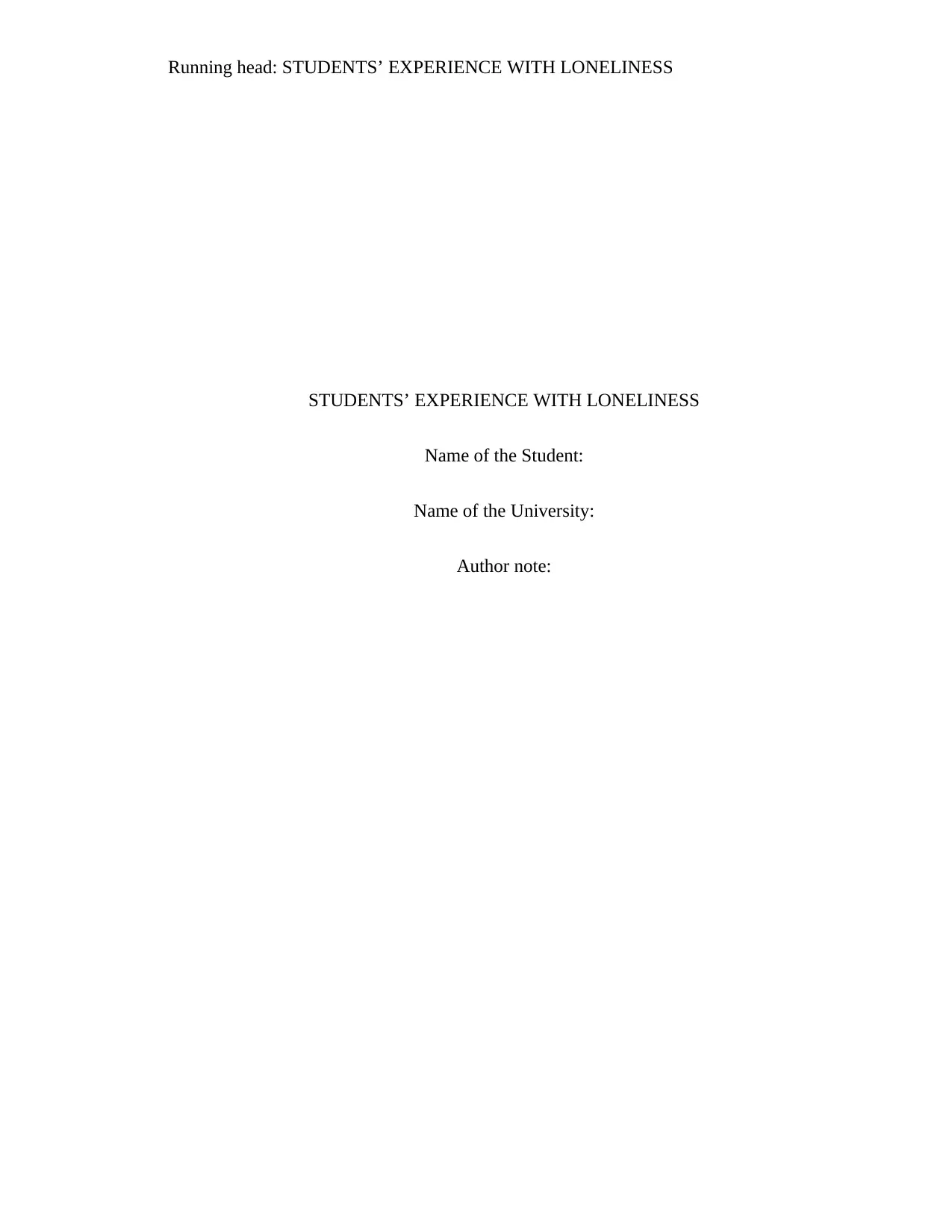
Running head: STUDENTS’ EXPERIENCE WITH LONELINESS
STUDENTS’ EXPERIENCE WITH LONELINESS
Name of the Student:
Name of the University:
Author note:
STUDENTS’ EXPERIENCE WITH LONELINESS
Name of the Student:
Name of the University:
Author note:
Paraphrase This Document
Need a fresh take? Get an instant paraphrase of this document with our AI Paraphraser
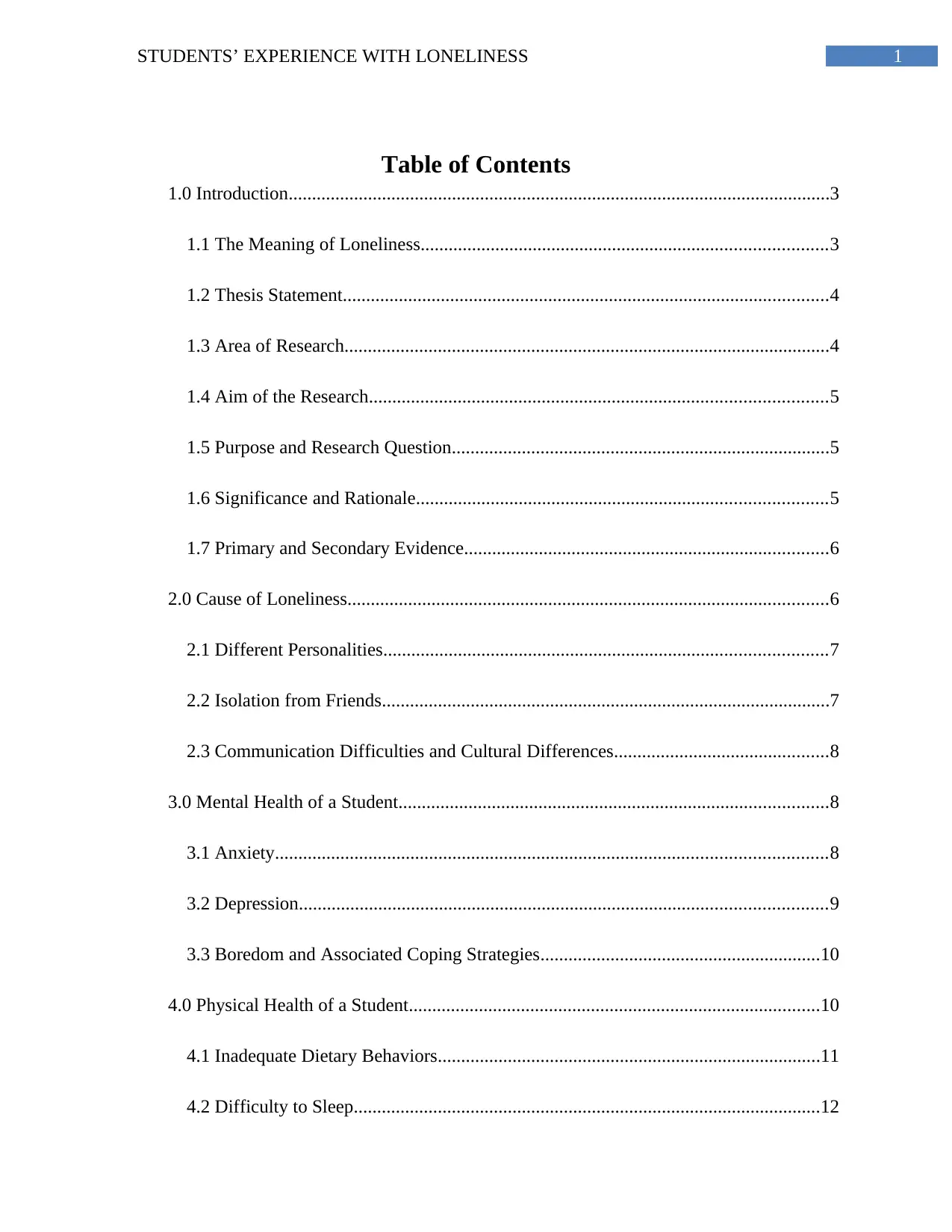
1STUDENTS’ EXPERIENCE WITH LONELINESS
Table of Contents
1.0 Introduction....................................................................................................................3
1.1 The Meaning of Loneliness.......................................................................................3
1.2 Thesis Statement........................................................................................................4
1.3 Area of Research........................................................................................................4
1.4 Aim of the Research..................................................................................................5
1.5 Purpose and Research Question.................................................................................5
1.6 Significance and Rationale........................................................................................5
1.7 Primary and Secondary Evidence..............................................................................6
2.0 Cause of Loneliness.......................................................................................................6
2.1 Different Personalities...............................................................................................7
2.2 Isolation from Friends................................................................................................7
2.3 Communication Difficulties and Cultural Differences..............................................8
3.0 Mental Health of a Student............................................................................................8
3.1 Anxiety......................................................................................................................8
3.2 Depression.................................................................................................................9
3.3 Boredom and Associated Coping Strategies............................................................10
4.0 Physical Health of a Student........................................................................................10
4.1 Inadequate Dietary Behaviors..................................................................................11
4.2 Difficulty to Sleep....................................................................................................12
Table of Contents
1.0 Introduction....................................................................................................................3
1.1 The Meaning of Loneliness.......................................................................................3
1.2 Thesis Statement........................................................................................................4
1.3 Area of Research........................................................................................................4
1.4 Aim of the Research..................................................................................................5
1.5 Purpose and Research Question.................................................................................5
1.6 Significance and Rationale........................................................................................5
1.7 Primary and Secondary Evidence..............................................................................6
2.0 Cause of Loneliness.......................................................................................................6
2.1 Different Personalities...............................................................................................7
2.2 Isolation from Friends................................................................................................7
2.3 Communication Difficulties and Cultural Differences..............................................8
3.0 Mental Health of a Student............................................................................................8
3.1 Anxiety......................................................................................................................8
3.2 Depression.................................................................................................................9
3.3 Boredom and Associated Coping Strategies............................................................10
4.0 Physical Health of a Student........................................................................................10
4.1 Inadequate Dietary Behaviors..................................................................................11
4.2 Difficulty to Sleep....................................................................................................12
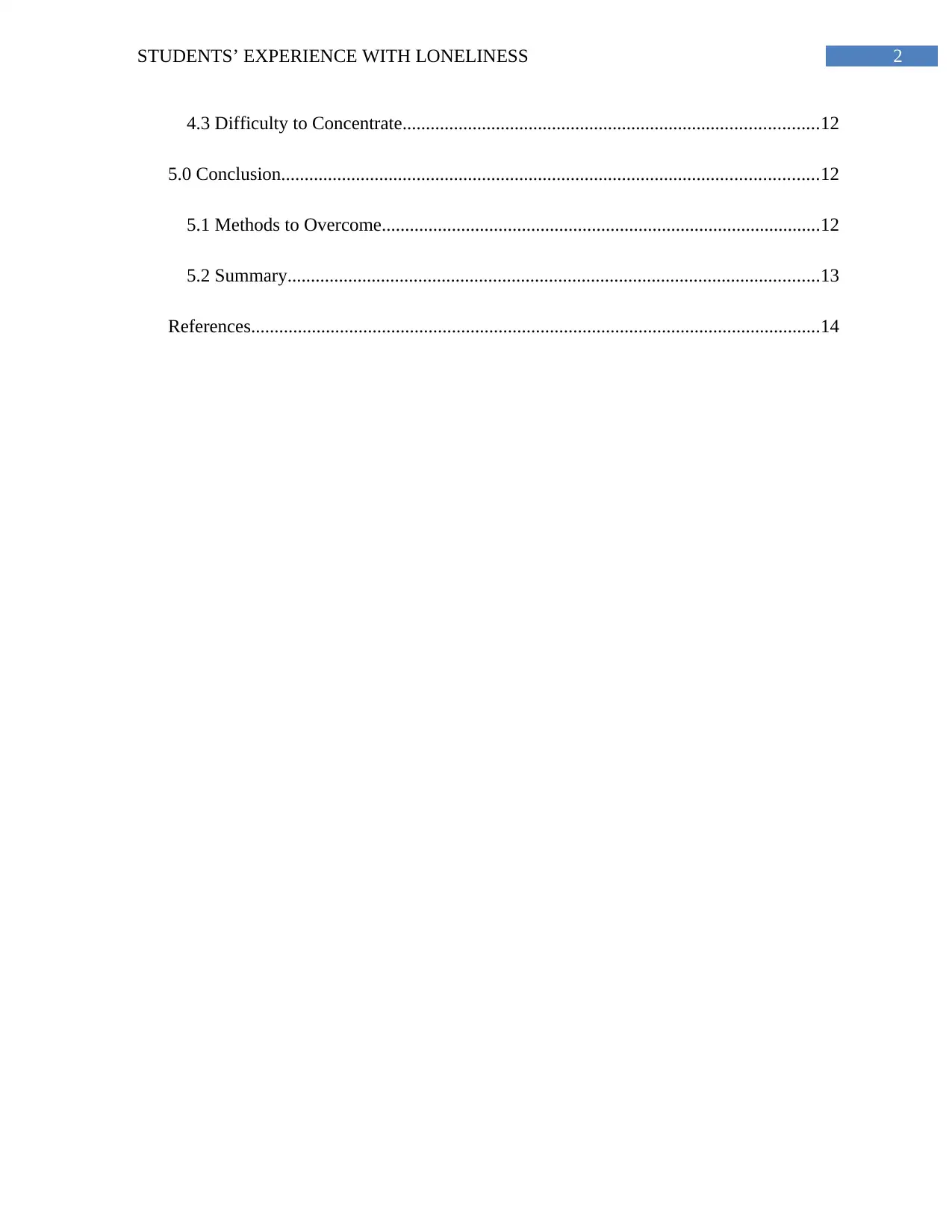
2STUDENTS’ EXPERIENCE WITH LONELINESS
4.3 Difficulty to Concentrate.........................................................................................12
5.0 Conclusion...................................................................................................................12
5.1 Methods to Overcome..............................................................................................12
5.2 Summary..................................................................................................................13
References..........................................................................................................................14
4.3 Difficulty to Concentrate.........................................................................................12
5.0 Conclusion...................................................................................................................12
5.1 Methods to Overcome..............................................................................................12
5.2 Summary..................................................................................................................13
References..........................................................................................................................14
⊘ This is a preview!⊘
Do you want full access?
Subscribe today to unlock all pages.

Trusted by 1+ million students worldwide
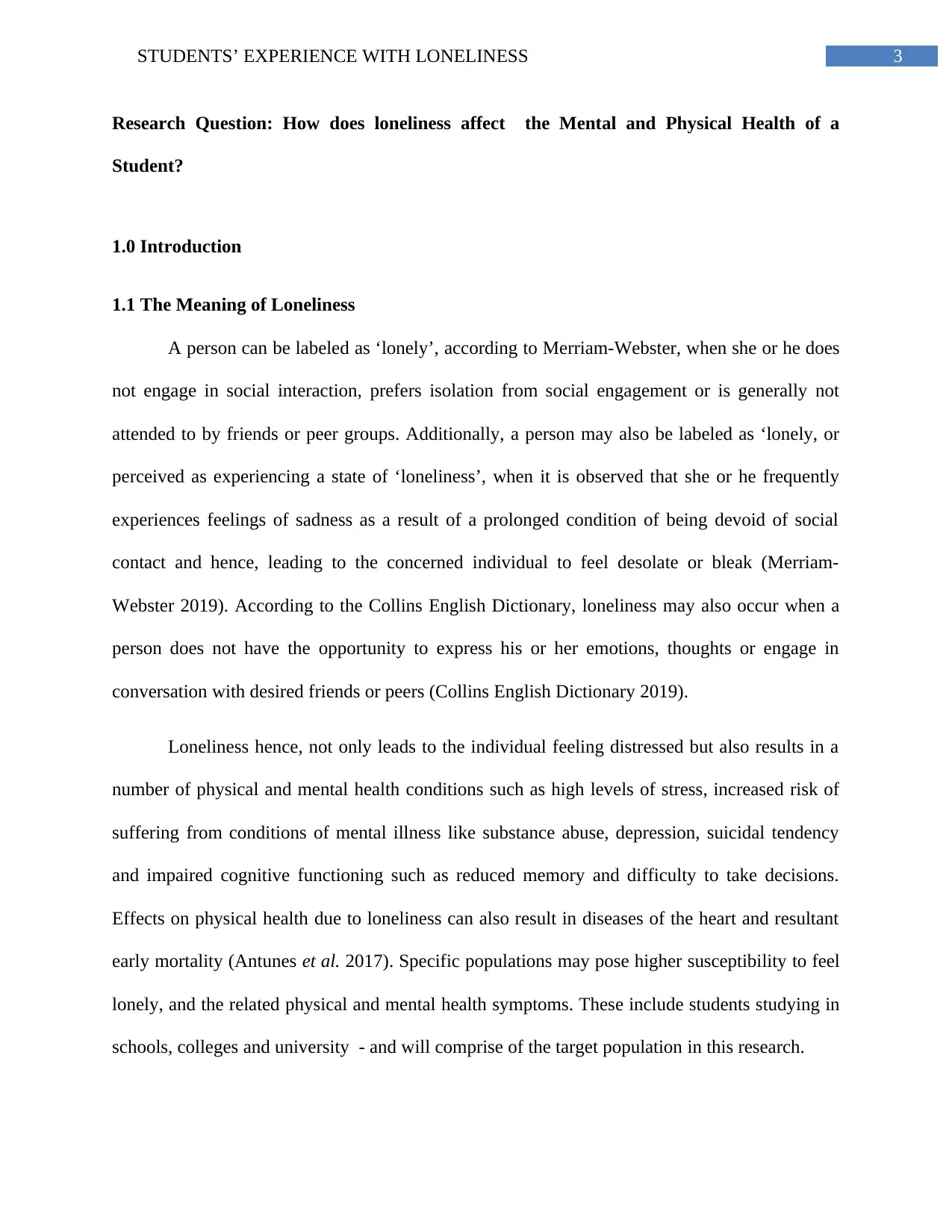
3STUDENTS’ EXPERIENCE WITH LONELINESS
Research Question: How does loneliness affect the Mental and Physical Health of a
Student?
1.0 Introduction
1.1 The Meaning of Loneliness
A person can be labeled as ‘lonely’, according to Merriam-Webster, when she or he does
not engage in social interaction, prefers isolation from social engagement or is generally not
attended to by friends or peer groups. Additionally, a person may also be labeled as ‘lonely, or
perceived as experiencing a state of ‘loneliness’, when it is observed that she or he frequently
experiences feelings of sadness as a result of a prolonged condition of being devoid of social
contact and hence, leading to the concerned individual to feel desolate or bleak (Merriam-
Webster 2019). According to the Collins English Dictionary, loneliness may also occur when a
person does not have the opportunity to express his or her emotions, thoughts or engage in
conversation with desired friends or peers (Collins English Dictionary 2019).
Loneliness hence, not only leads to the individual feeling distressed but also results in a
number of physical and mental health conditions such as high levels of stress, increased risk of
suffering from conditions of mental illness like substance abuse, depression, suicidal tendency
and impaired cognitive functioning such as reduced memory and difficulty to take decisions.
Effects on physical health due to loneliness can also result in diseases of the heart and resultant
early mortality (Antunes et al. 2017). Specific populations may pose higher susceptibility to feel
lonely, and the related physical and mental health symptoms. These include students studying in
schools, colleges and university - and will comprise of the target population in this research.
Research Question: How does loneliness affect the Mental and Physical Health of a
Student?
1.0 Introduction
1.1 The Meaning of Loneliness
A person can be labeled as ‘lonely’, according to Merriam-Webster, when she or he does
not engage in social interaction, prefers isolation from social engagement or is generally not
attended to by friends or peer groups. Additionally, a person may also be labeled as ‘lonely, or
perceived as experiencing a state of ‘loneliness’, when it is observed that she or he frequently
experiences feelings of sadness as a result of a prolonged condition of being devoid of social
contact and hence, leading to the concerned individual to feel desolate or bleak (Merriam-
Webster 2019). According to the Collins English Dictionary, loneliness may also occur when a
person does not have the opportunity to express his or her emotions, thoughts or engage in
conversation with desired friends or peers (Collins English Dictionary 2019).
Loneliness hence, not only leads to the individual feeling distressed but also results in a
number of physical and mental health conditions such as high levels of stress, increased risk of
suffering from conditions of mental illness like substance abuse, depression, suicidal tendency
and impaired cognitive functioning such as reduced memory and difficulty to take decisions.
Effects on physical health due to loneliness can also result in diseases of the heart and resultant
early mortality (Antunes et al. 2017). Specific populations may pose higher susceptibility to feel
lonely, and the related physical and mental health symptoms. These include students studying in
schools, colleges and university - and will comprise of the target population in this research.
Paraphrase This Document
Need a fresh take? Get an instant paraphrase of this document with our AI Paraphraser
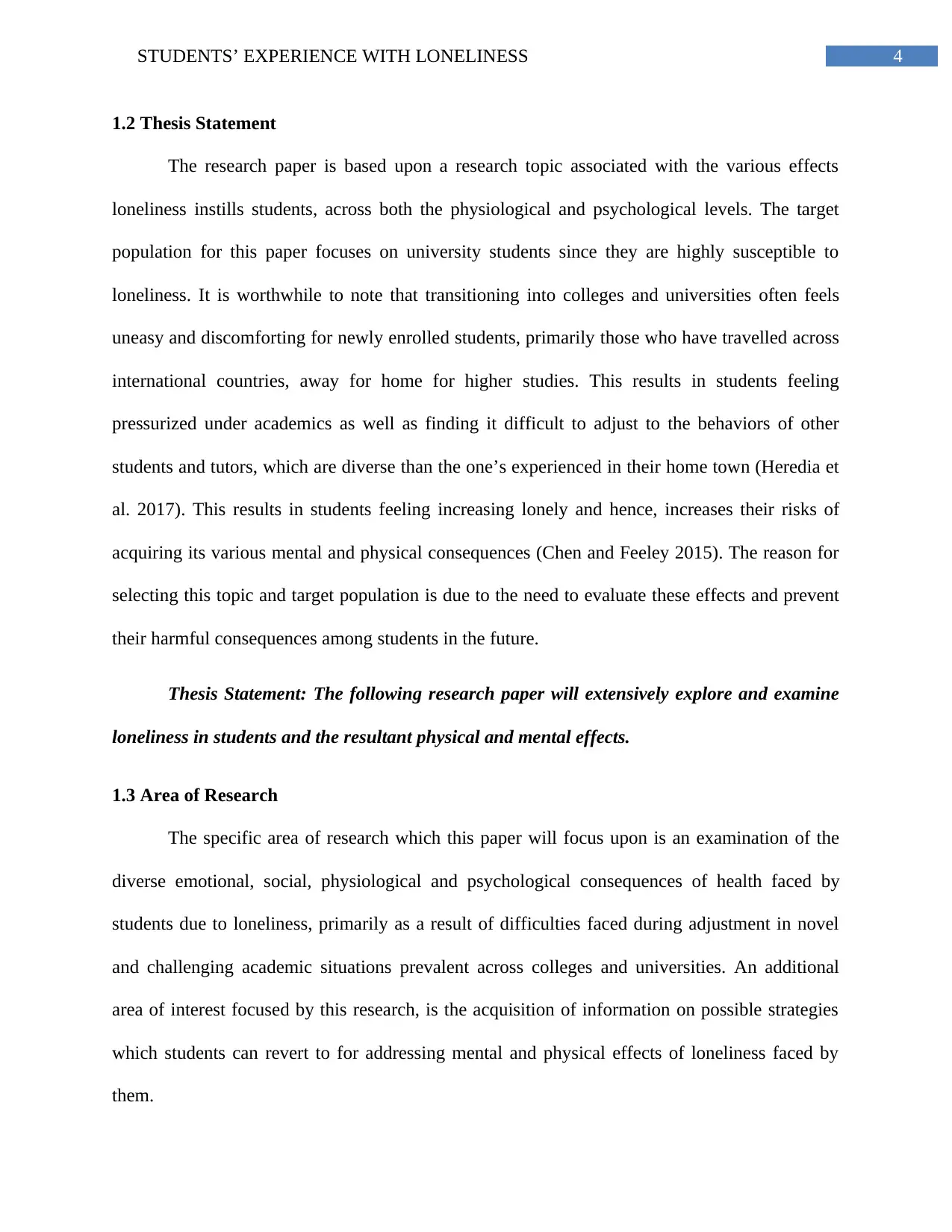
4STUDENTS’ EXPERIENCE WITH LONELINESS
1.2 Thesis Statement
The research paper is based upon a research topic associated with the various effects
loneliness instills students, across both the physiological and psychological levels. The target
population for this paper focuses on university students since they are highly susceptible to
loneliness. It is worthwhile to note that transitioning into colleges and universities often feels
uneasy and discomforting for newly enrolled students, primarily those who have travelled across
international countries, away for home for higher studies. This results in students feeling
pressurized under academics as well as finding it difficult to adjust to the behaviors of other
students and tutors, which are diverse than the one’s experienced in their home town (Heredia et
al. 2017). This results in students feeling increasing lonely and hence, increases their risks of
acquiring its various mental and physical consequences (Chen and Feeley 2015). The reason for
selecting this topic and target population is due to the need to evaluate these effects and prevent
their harmful consequences among students in the future.
Thesis Statement: The following research paper will extensively explore and examine
loneliness in students and the resultant physical and mental effects.
1.3 Area of Research
The specific area of research which this paper will focus upon is an examination of the
diverse emotional, social, physiological and psychological consequences of health faced by
students due to loneliness, primarily as a result of difficulties faced during adjustment in novel
and challenging academic situations prevalent across colleges and universities. An additional
area of interest focused by this research, is the acquisition of information on possible strategies
which students can revert to for addressing mental and physical effects of loneliness faced by
them.
1.2 Thesis Statement
The research paper is based upon a research topic associated with the various effects
loneliness instills students, across both the physiological and psychological levels. The target
population for this paper focuses on university students since they are highly susceptible to
loneliness. It is worthwhile to note that transitioning into colleges and universities often feels
uneasy and discomforting for newly enrolled students, primarily those who have travelled across
international countries, away for home for higher studies. This results in students feeling
pressurized under academics as well as finding it difficult to adjust to the behaviors of other
students and tutors, which are diverse than the one’s experienced in their home town (Heredia et
al. 2017). This results in students feeling increasing lonely and hence, increases their risks of
acquiring its various mental and physical consequences (Chen and Feeley 2015). The reason for
selecting this topic and target population is due to the need to evaluate these effects and prevent
their harmful consequences among students in the future.
Thesis Statement: The following research paper will extensively explore and examine
loneliness in students and the resultant physical and mental effects.
1.3 Area of Research
The specific area of research which this paper will focus upon is an examination of the
diverse emotional, social, physiological and psychological consequences of health faced by
students due to loneliness, primarily as a result of difficulties faced during adjustment in novel
and challenging academic situations prevalent across colleges and universities. An additional
area of interest focused by this research, is the acquisition of information on possible strategies
which students can revert to for addressing mental and physical effects of loneliness faced by
them.
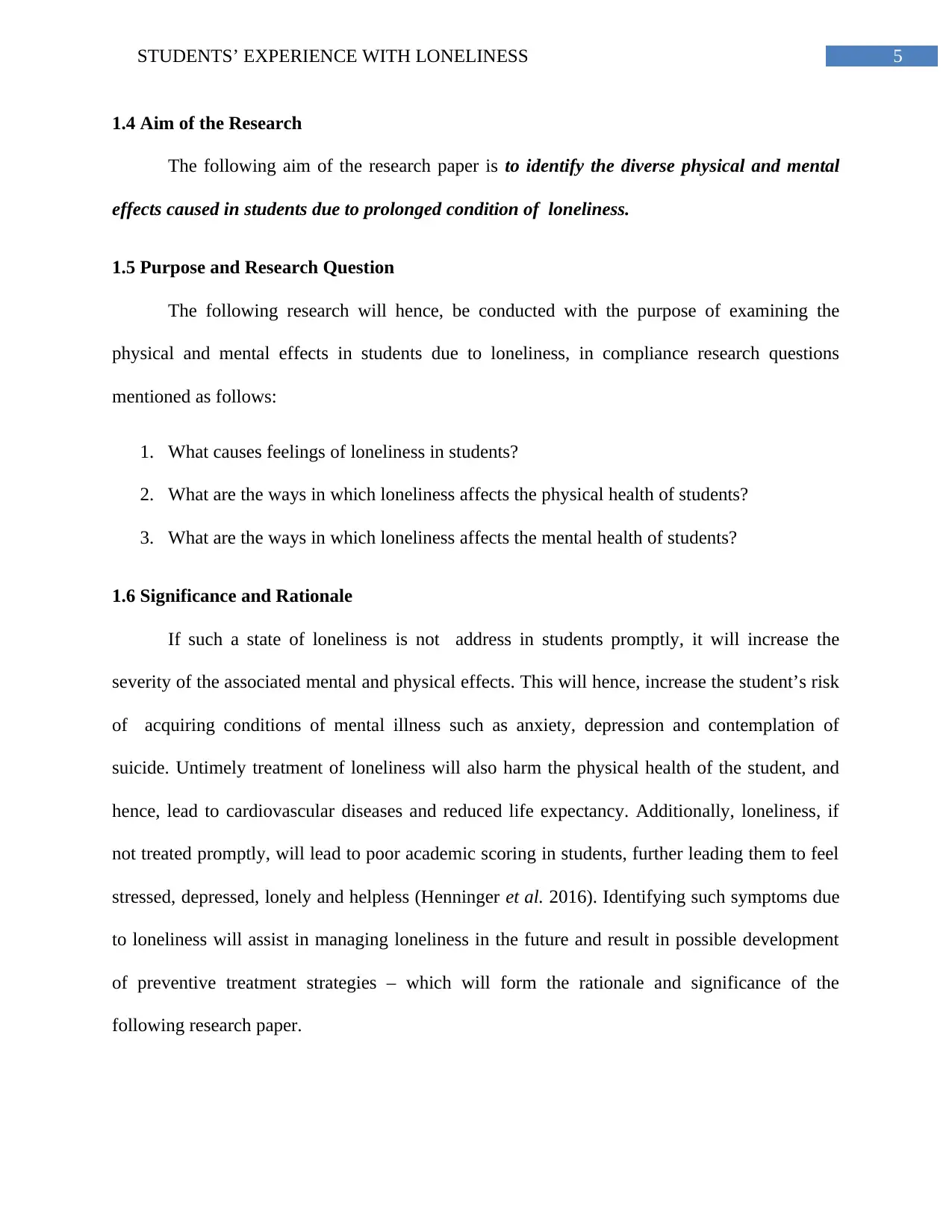
5STUDENTS’ EXPERIENCE WITH LONELINESS
1.4 Aim of the Research
The following aim of the research paper is to identify the diverse physical and mental
effects caused in students due to prolonged condition of loneliness.
1.5 Purpose and Research Question
The following research will hence, be conducted with the purpose of examining the
physical and mental effects in students due to loneliness, in compliance research questions
mentioned as follows:
1. What causes feelings of loneliness in students?
2. What are the ways in which loneliness affects the physical health of students?
3. What are the ways in which loneliness affects the mental health of students?
1.6 Significance and Rationale
If such a state of loneliness is not address in students promptly, it will increase the
severity of the associated mental and physical effects. This will hence, increase the student’s risk
of acquiring conditions of mental illness such as anxiety, depression and contemplation of
suicide. Untimely treatment of loneliness will also harm the physical health of the student, and
hence, lead to cardiovascular diseases and reduced life expectancy. Additionally, loneliness, if
not treated promptly, will lead to poor academic scoring in students, further leading them to feel
stressed, depressed, lonely and helpless (Henninger et al. 2016). Identifying such symptoms due
to loneliness will assist in managing loneliness in the future and result in possible development
of preventive treatment strategies – which will form the rationale and significance of the
following research paper.
1.4 Aim of the Research
The following aim of the research paper is to identify the diverse physical and mental
effects caused in students due to prolonged condition of loneliness.
1.5 Purpose and Research Question
The following research will hence, be conducted with the purpose of examining the
physical and mental effects in students due to loneliness, in compliance research questions
mentioned as follows:
1. What causes feelings of loneliness in students?
2. What are the ways in which loneliness affects the physical health of students?
3. What are the ways in which loneliness affects the mental health of students?
1.6 Significance and Rationale
If such a state of loneliness is not address in students promptly, it will increase the
severity of the associated mental and physical effects. This will hence, increase the student’s risk
of acquiring conditions of mental illness such as anxiety, depression and contemplation of
suicide. Untimely treatment of loneliness will also harm the physical health of the student, and
hence, lead to cardiovascular diseases and reduced life expectancy. Additionally, loneliness, if
not treated promptly, will lead to poor academic scoring in students, further leading them to feel
stressed, depressed, lonely and helpless (Henninger et al. 2016). Identifying such symptoms due
to loneliness will assist in managing loneliness in the future and result in possible development
of preventive treatment strategies – which will form the rationale and significance of the
following research paper.
⊘ This is a preview!⊘
Do you want full access?
Subscribe today to unlock all pages.

Trusted by 1+ million students worldwide
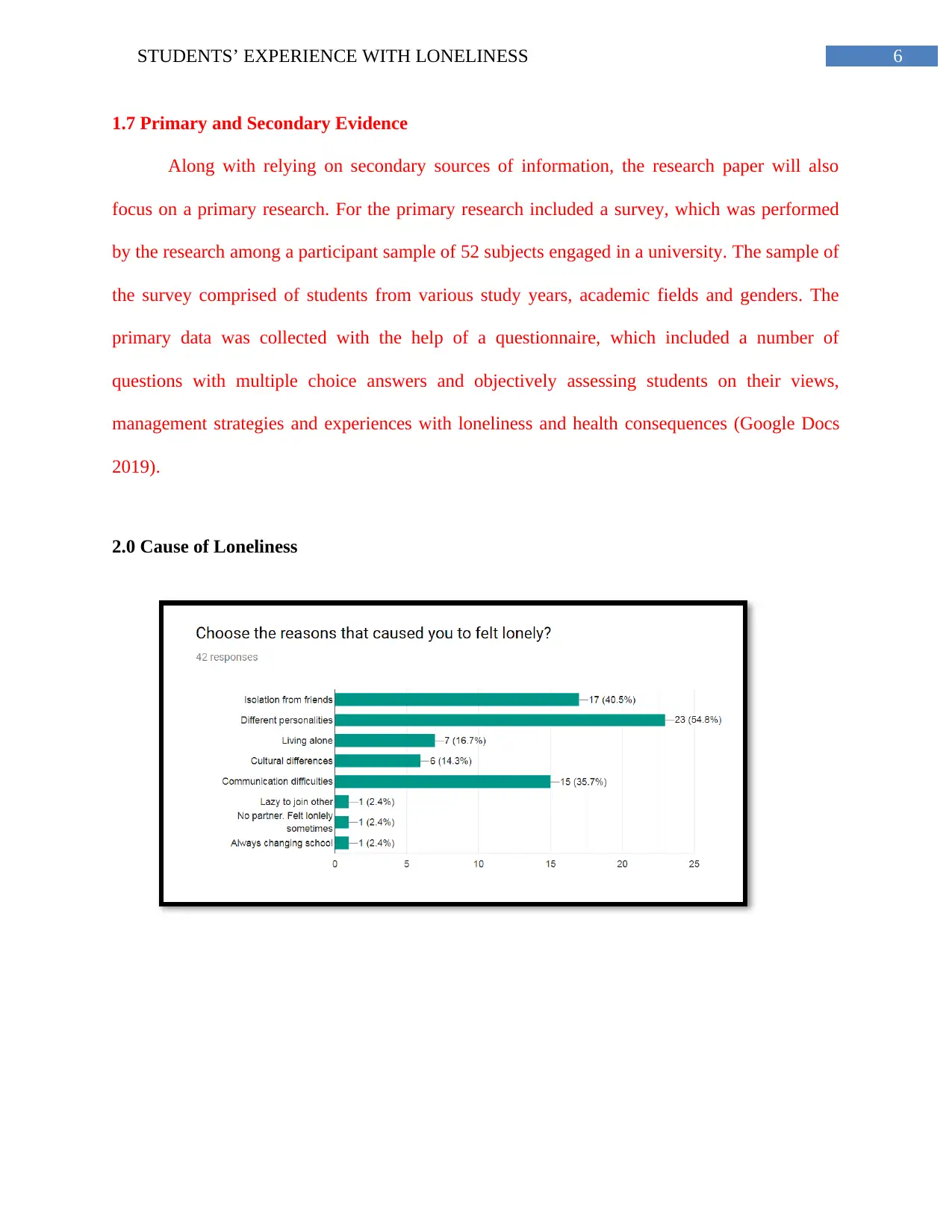
6STUDENTS’ EXPERIENCE WITH LONELINESS
1.7 Primary and Secondary Evidence
Along with relying on secondary sources of information, the research paper will also
focus on a primary research. For the primary research included a survey, which was performed
by the research among a participant sample of 52 subjects engaged in a university. The sample of
the survey comprised of students from various study years, academic fields and genders. The
primary data was collected with the help of a questionnaire, which included a number of
questions with multiple choice answers and objectively assessing students on their views,
management strategies and experiences with loneliness and health consequences (Google Docs
2019).
2.0 Cause of Loneliness
1.7 Primary and Secondary Evidence
Along with relying on secondary sources of information, the research paper will also
focus on a primary research. For the primary research included a survey, which was performed
by the research among a participant sample of 52 subjects engaged in a university. The sample of
the survey comprised of students from various study years, academic fields and genders. The
primary data was collected with the help of a questionnaire, which included a number of
questions with multiple choice answers and objectively assessing students on their views,
management strategies and experiences with loneliness and health consequences (Google Docs
2019).
2.0 Cause of Loneliness
Paraphrase This Document
Need a fresh take? Get an instant paraphrase of this document with our AI Paraphraser
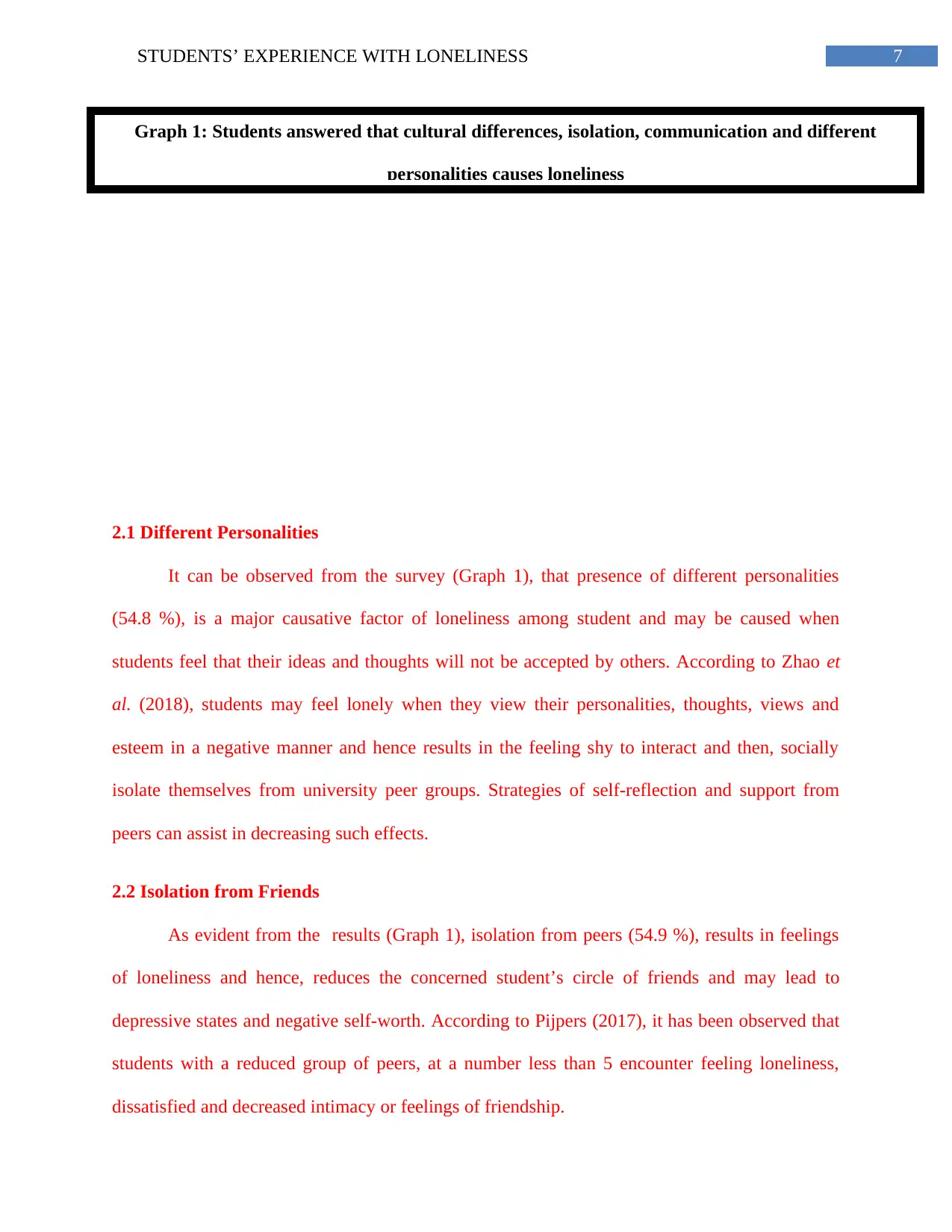
7STUDENTS’ EXPERIENCE WITH LONELINESS
2.1 Different Personalities
It can be observed from the survey (Graph 1), that presence of different personalities
(54.8 %), is a major causative factor of loneliness among student and may be caused when
students feel that their ideas and thoughts will not be accepted by others. According to Zhao et
al. (2018), students may feel lonely when they view their personalities, thoughts, views and
esteem in a negative manner and hence results in the feeling shy to interact and then, socially
isolate themselves from university peer groups. Strategies of self-reflection and support from
peers can assist in decreasing such effects.
2.2 Isolation from Friends
As evident from the results (Graph 1), isolation from peers (54.9 %), results in feelings
of loneliness and hence, reduces the concerned student’s circle of friends and may lead to
depressive states and negative self-worth. According to Pijpers (2017), it has been observed that
students with a reduced group of peers, at a number less than 5 encounter feeling loneliness,
dissatisfied and decreased intimacy or feelings of friendship.
Graph 1: Students answered that cultural differences, isolation, communication and different
personalities causes loneliness
2.1 Different Personalities
It can be observed from the survey (Graph 1), that presence of different personalities
(54.8 %), is a major causative factor of loneliness among student and may be caused when
students feel that their ideas and thoughts will not be accepted by others. According to Zhao et
al. (2018), students may feel lonely when they view their personalities, thoughts, views and
esteem in a negative manner and hence results in the feeling shy to interact and then, socially
isolate themselves from university peer groups. Strategies of self-reflection and support from
peers can assist in decreasing such effects.
2.2 Isolation from Friends
As evident from the results (Graph 1), isolation from peers (54.9 %), results in feelings
of loneliness and hence, reduces the concerned student’s circle of friends and may lead to
depressive states and negative self-worth. According to Pijpers (2017), it has been observed that
students with a reduced group of peers, at a number less than 5 encounter feeling loneliness,
dissatisfied and decreased intimacy or feelings of friendship.
Graph 1: Students answered that cultural differences, isolation, communication and different
personalities causes loneliness
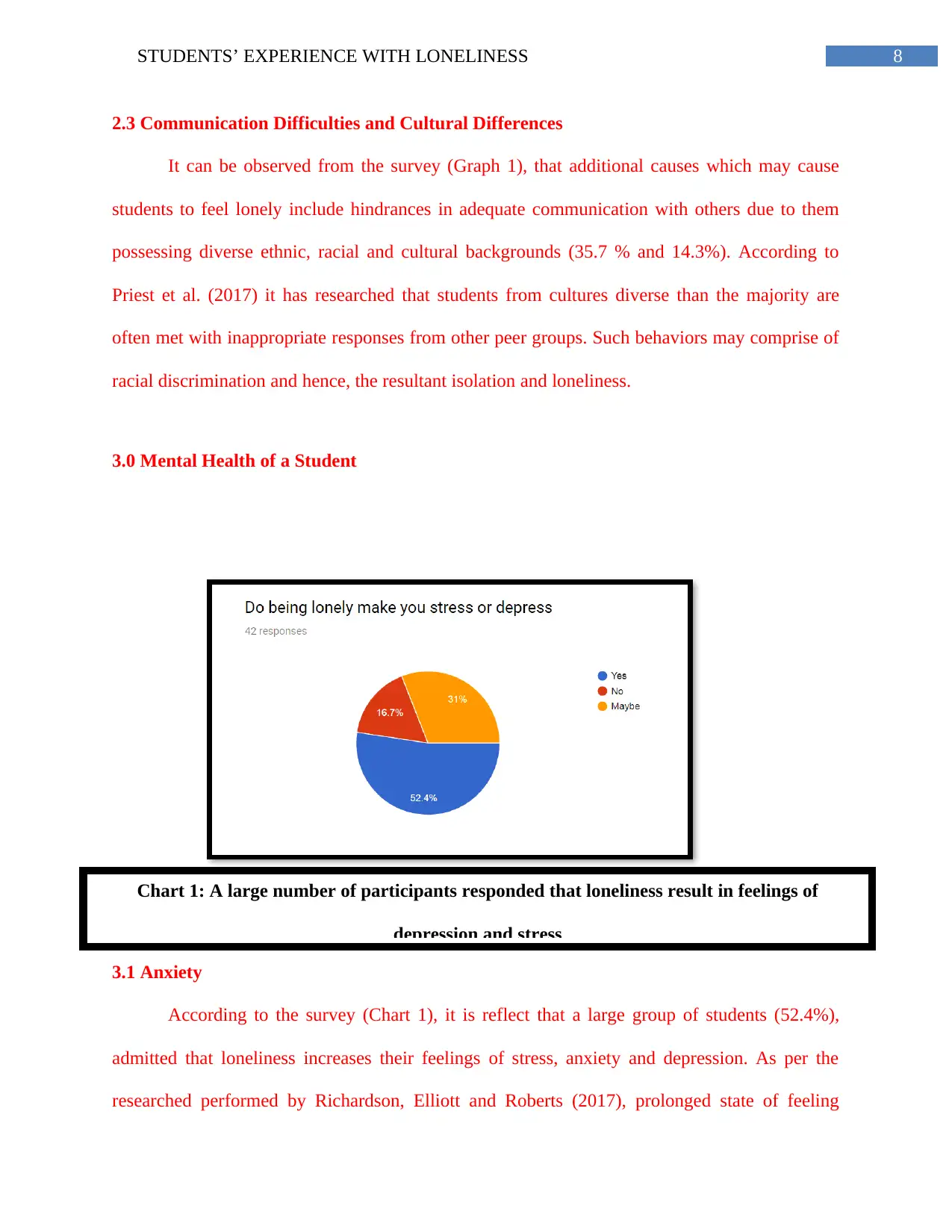
8STUDENTS’ EXPERIENCE WITH LONELINESS
2.3 Communication Difficulties and Cultural Differences
It can be observed from the survey (Graph 1), that additional causes which may cause
students to feel lonely include hindrances in adequate communication with others due to them
possessing diverse ethnic, racial and cultural backgrounds (35.7 % and 14.3%). According to
Priest et al. (2017) it has researched that students from cultures diverse than the majority are
often met with inappropriate responses from other peer groups. Such behaviors may comprise of
racial discrimination and hence, the resultant isolation and loneliness.
3.0 Mental Health of a Student
3.1 Anxiety
According to the survey (Chart 1), it is reflect that a large group of students (52.4%),
admitted that loneliness increases their feelings of stress, anxiety and depression. As per the
researched performed by Richardson, Elliott and Roberts (2017), prolonged state of feeling
Chart 1: A large number of participants responded that loneliness result in feelings of
depression and stress
2.3 Communication Difficulties and Cultural Differences
It can be observed from the survey (Graph 1), that additional causes which may cause
students to feel lonely include hindrances in adequate communication with others due to them
possessing diverse ethnic, racial and cultural backgrounds (35.7 % and 14.3%). According to
Priest et al. (2017) it has researched that students from cultures diverse than the majority are
often met with inappropriate responses from other peer groups. Such behaviors may comprise of
racial discrimination and hence, the resultant isolation and loneliness.
3.0 Mental Health of a Student
3.1 Anxiety
According to the survey (Chart 1), it is reflect that a large group of students (52.4%),
admitted that loneliness increases their feelings of stress, anxiety and depression. As per the
researched performed by Richardson, Elliott and Roberts (2017), prolonged state of feeling
Chart 1: A large number of participants responded that loneliness result in feelings of
depression and stress
⊘ This is a preview!⊘
Do you want full access?
Subscribe today to unlock all pages.

Trusted by 1+ million students worldwide
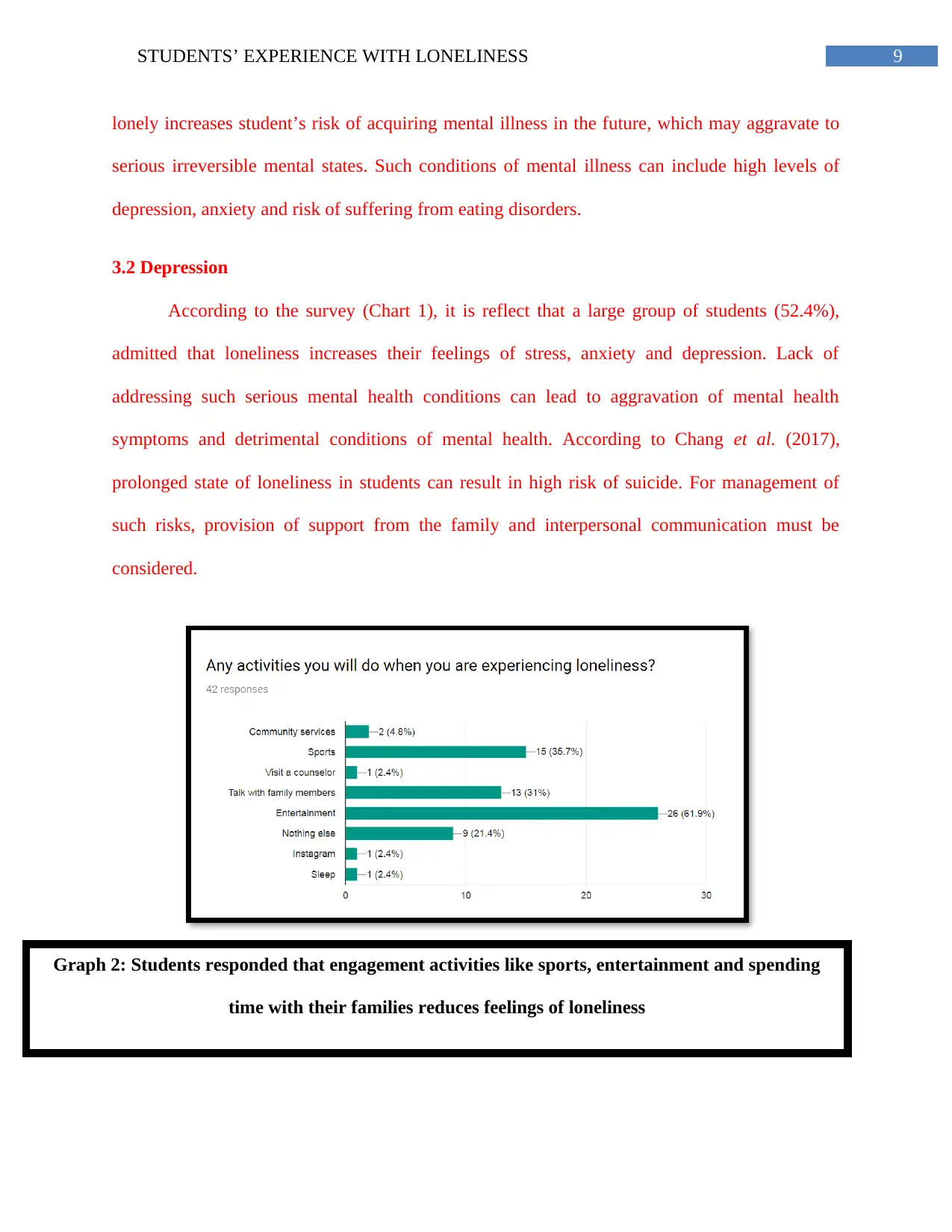
9STUDENTS’ EXPERIENCE WITH LONELINESS
lonely increases student’s risk of acquiring mental illness in the future, which may aggravate to
serious irreversible mental states. Such conditions of mental illness can include high levels of
depression, anxiety and risk of suffering from eating disorders.
3.2 Depression
According to the survey (Chart 1), it is reflect that a large group of students (52.4%),
admitted that loneliness increases their feelings of stress, anxiety and depression. Lack of
addressing such serious mental health conditions can lead to aggravation of mental health
symptoms and detrimental conditions of mental health. According to Chang et al. (2017),
prolonged state of loneliness in students can result in high risk of suicide. For management of
such risks, provision of support from the family and interpersonal communication must be
considered.
Graph 2: Students responded that engagement activities like sports, entertainment and spending
time with their families reduces feelings of loneliness
lonely increases student’s risk of acquiring mental illness in the future, which may aggravate to
serious irreversible mental states. Such conditions of mental illness can include high levels of
depression, anxiety and risk of suffering from eating disorders.
3.2 Depression
According to the survey (Chart 1), it is reflect that a large group of students (52.4%),
admitted that loneliness increases their feelings of stress, anxiety and depression. Lack of
addressing such serious mental health conditions can lead to aggravation of mental health
symptoms and detrimental conditions of mental health. According to Chang et al. (2017),
prolonged state of loneliness in students can result in high risk of suicide. For management of
such risks, provision of support from the family and interpersonal communication must be
considered.
Graph 2: Students responded that engagement activities like sports, entertainment and spending
time with their families reduces feelings of loneliness
Paraphrase This Document
Need a fresh take? Get an instant paraphrase of this document with our AI Paraphraser
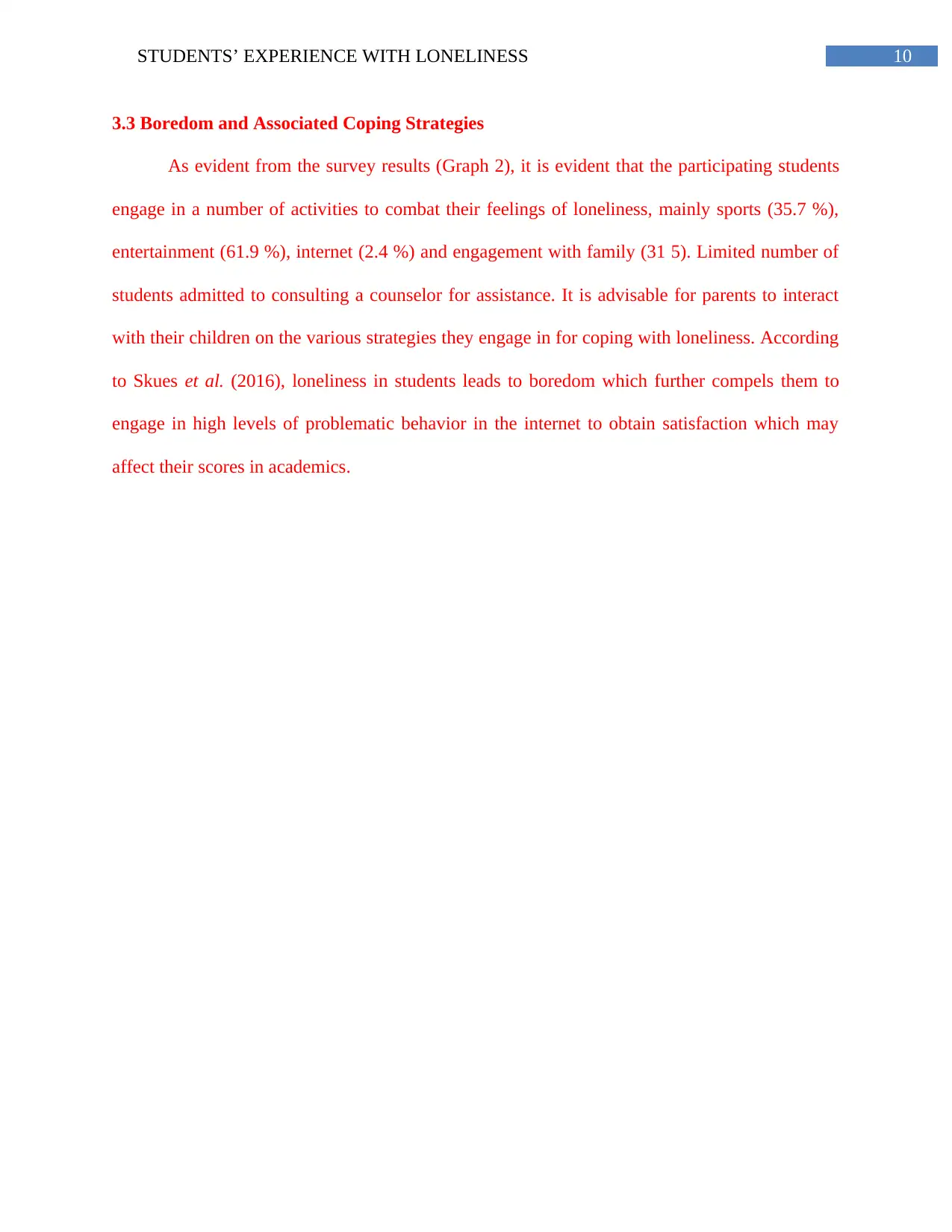
10STUDENTS’ EXPERIENCE WITH LONELINESS
3.3 Boredom and Associated Coping Strategies
As evident from the survey results (Graph 2), it is evident that the participating students
engage in a number of activities to combat their feelings of loneliness, mainly sports (35.7 %),
entertainment (61.9 %), internet (2.4 %) and engagement with family (31 5). Limited number of
students admitted to consulting a counselor for assistance. It is advisable for parents to interact
with their children on the various strategies they engage in for coping with loneliness. According
to Skues et al. (2016), loneliness in students leads to boredom which further compels them to
engage in high levels of problematic behavior in the internet to obtain satisfaction which may
affect their scores in academics.
3.3 Boredom and Associated Coping Strategies
As evident from the survey results (Graph 2), it is evident that the participating students
engage in a number of activities to combat their feelings of loneliness, mainly sports (35.7 %),
entertainment (61.9 %), internet (2.4 %) and engagement with family (31 5). Limited number of
students admitted to consulting a counselor for assistance. It is advisable for parents to interact
with their children on the various strategies they engage in for coping with loneliness. According
to Skues et al. (2016), loneliness in students leads to boredom which further compels them to
engage in high levels of problematic behavior in the internet to obtain satisfaction which may
affect their scores in academics.
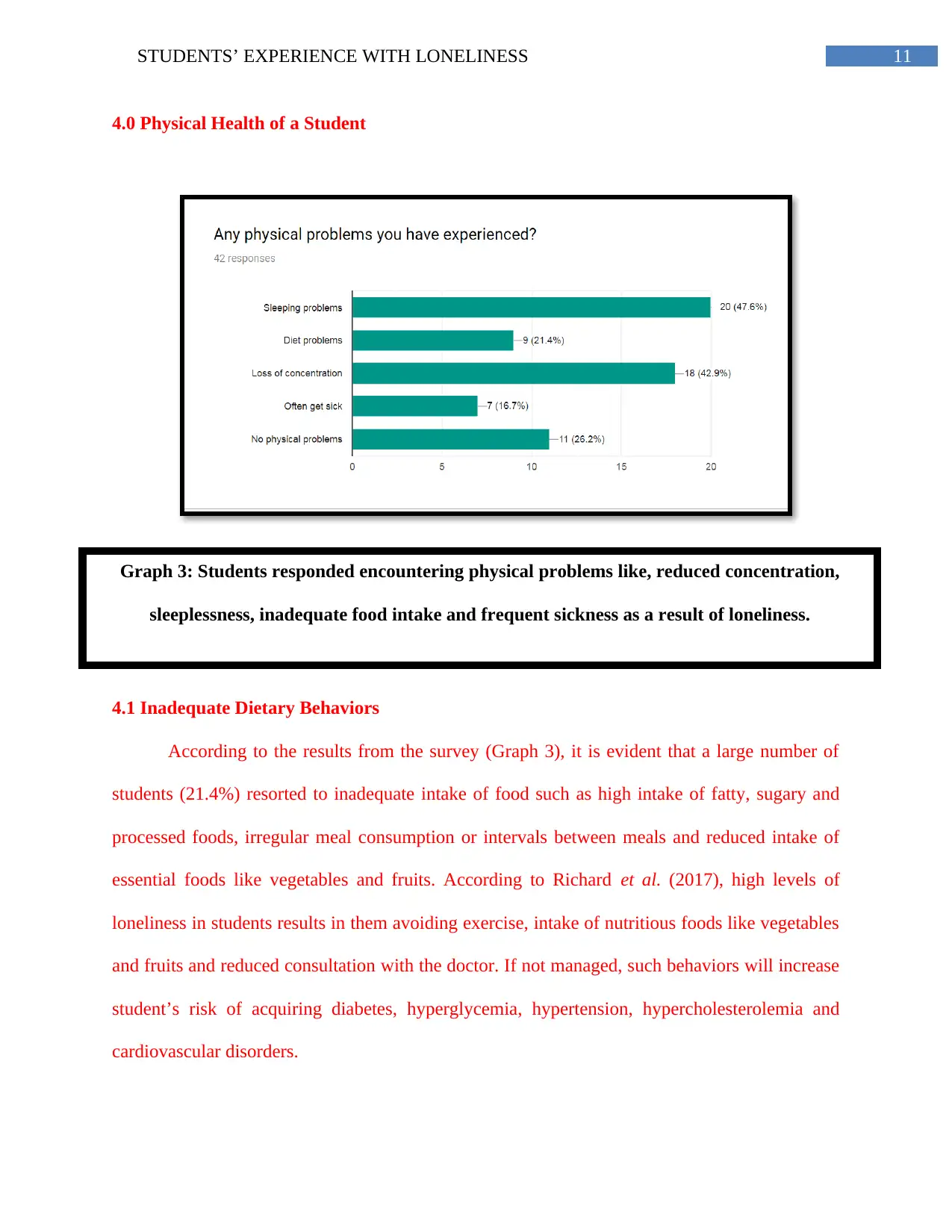
11STUDENTS’ EXPERIENCE WITH LONELINESS
4.0 Physical Health of a Student
4.1 Inadequate Dietary Behaviors
According to the results from the survey (Graph 3), it is evident that a large number of
students (21.4%) resorted to inadequate intake of food such as high intake of fatty, sugary and
processed foods, irregular meal consumption or intervals between meals and reduced intake of
essential foods like vegetables and fruits. According to Richard et al. (2017), high levels of
loneliness in students results in them avoiding exercise, intake of nutritious foods like vegetables
and fruits and reduced consultation with the doctor. If not managed, such behaviors will increase
student’s risk of acquiring diabetes, hyperglycemia, hypertension, hypercholesterolemia and
cardiovascular disorders.
Graph 3: Students responded encountering physical problems like, reduced concentration,
sleeplessness, inadequate food intake and frequent sickness as a result of loneliness.
4.0 Physical Health of a Student
4.1 Inadequate Dietary Behaviors
According to the results from the survey (Graph 3), it is evident that a large number of
students (21.4%) resorted to inadequate intake of food such as high intake of fatty, sugary and
processed foods, irregular meal consumption or intervals between meals and reduced intake of
essential foods like vegetables and fruits. According to Richard et al. (2017), high levels of
loneliness in students results in them avoiding exercise, intake of nutritious foods like vegetables
and fruits and reduced consultation with the doctor. If not managed, such behaviors will increase
student’s risk of acquiring diabetes, hyperglycemia, hypertension, hypercholesterolemia and
cardiovascular disorders.
Graph 3: Students responded encountering physical problems like, reduced concentration,
sleeplessness, inadequate food intake and frequent sickness as a result of loneliness.
⊘ This is a preview!⊘
Do you want full access?
Subscribe today to unlock all pages.

Trusted by 1+ million students worldwide
1 out of 17
Related Documents
Your All-in-One AI-Powered Toolkit for Academic Success.
+13062052269
info@desklib.com
Available 24*7 on WhatsApp / Email
![[object Object]](/_next/static/media/star-bottom.7253800d.svg)
Unlock your academic potential
Copyright © 2020–2025 A2Z Services. All Rights Reserved. Developed and managed by ZUCOL.




